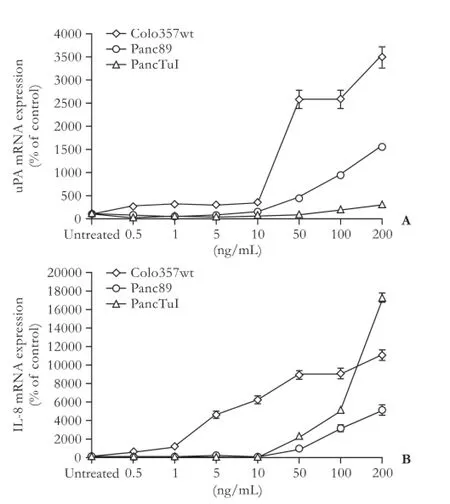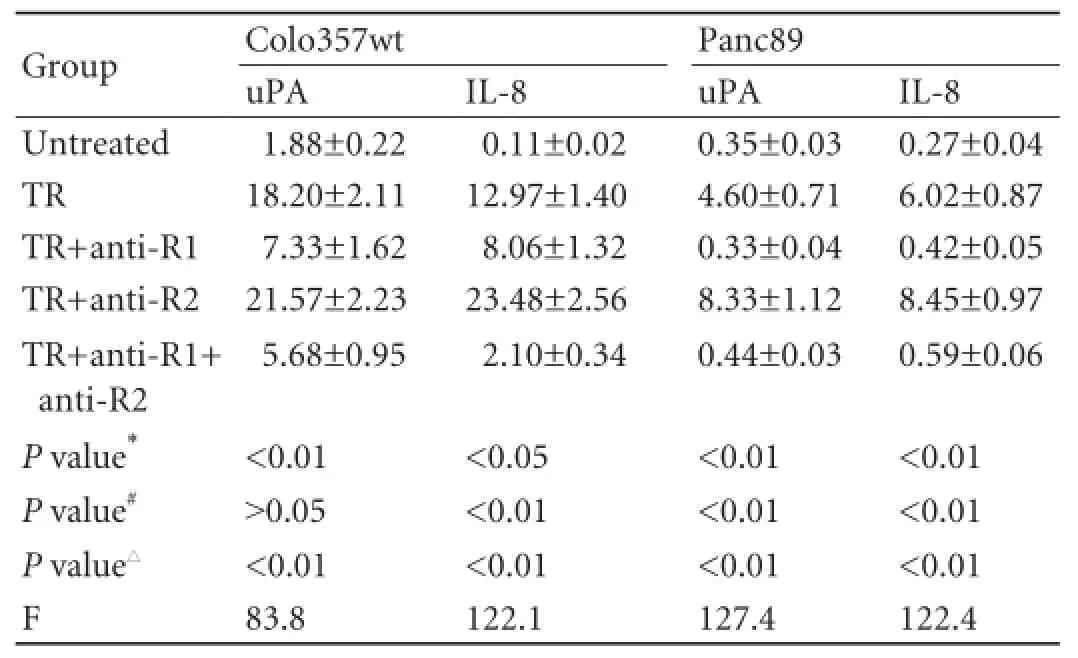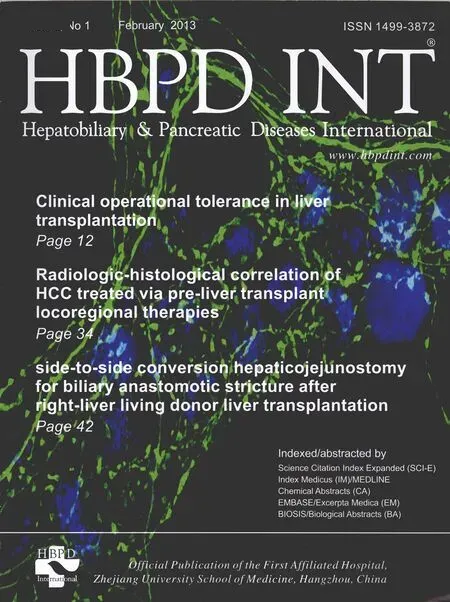TRAIL-induced expression of uPA and IL-8 strongly enhanced by overexpression of TRAF2 and Bcl-xL in pancreatic ductal adenocarcinoma cells
Hangzhou, China
TRAIL-induced expression of uPA and IL-8 strongly enhanced by overexpression of TRAF2 and Bcl-xL in pancreatic ductal adenocarcinoma cells
Dong-Hui Zhou, Li-Na Yang, Christian R?der, Holger Kalthoff and Anna Trauzold
Hangzhou, China
BACKGROUND:The death ligand, tumor necrosis factor (TNF)-related apoptosis-inducing ligand (TRAIL), induces apoptosis and non-apoptotic signaling in some tumor cells. The purpose of this study was to investigate the roles of the pro-apoptotic TRAIL receptors, TRAIL-R1 and TRAIL-R2, as well as Bcl-xL and TRAF2 in TRAIL-induced expression of the pro-inf l ammatory cytokine IL-8 and the invasion-promoting protein urokinase (uPA) in pancreatic ductal adenocarcinoma (PDAC) cells.
METHODS:Colo357wt, Colo357/TRAF2, Colo357/Bcl-xL, Panc89 and PancTuI cells were stimulated with TRAIL and uPA and IL-8 expression was detected using real-time PCR. Antagonistic, receptor-specif i c antibodies were used to investigate the effects of TRAIL-R1 or TRAIL-R2 inhibition.
RESULTS:Dose-dependent increases in uPA and IL-8 expression were detected following TRAIL stimulation in PDAC cells. These effects were inhibited when TRAIL-R1 but not TRAIL-R2 was blocked. Overexpression of TRAF2 or Bcl-xL strongly increased TRAIL-mediated upregulation of uPA and IL-8.
CONCLUSIONS:In PDAC cells, TRAIL strongly induced uPA and IL-8 via TRAIL-R1. This response was further enhanced in cells overexpressing TRAF2 and Bcl-xL. Therefore, inhibition of the non-apoptotic "side-effects" of TRAIL treatments by inactivation of TRAF2 and Bcl-xL might represent additional relevant strategies for the treatment of pancreatic cancer.
(Hepatobiliary Pancreat Dis Int 2013;12:94-98)
TRAIL; uPA; IL-8; Bcl-xL; pancreatic cancer cell
Introduction
Recently, considerable attention has been focused on the potential benef i ts of tumor necrosis factor (TNF)-related apoptosis-inducing ligand (TRAIL) for cancer therapy since many tumor cell types have been shown to be sensitive to TRAIL-induced apoptosis. In contrast, untransformed cells are typically TRAIL-resistant.[1]The structure of TRAIL is related to other members of the tumor necrosis family of cytokines, and its gene is located on chromosome 3 at position 3q26. TRAIL is capable of inducing apoptosis through a caspase-dependent pathway that is activated via the proapoptotic TRAIL receptors, TRAIL-R1 and TRAIL-R2, which contain cytoplasmic death domains.[2-5]Some studies have indicated that the combination of recombinant TRAIL and chemotherapy or radiotherapy enhances TRAIL-induced apoptotic effects.[6-9]Overall, the vast majority of TRAIL-related reports have investigated the therapeutic aspects and general sideeffects of TRAIL and the apoptotic signaling pathways of TRAIL receptors. However, it has become clear that TRAIL also induces several non-apoptotic signaling pathways.[10]In pancreatic ductal adenocarcinoma (PDAC) cells this leads to inf l ammation, invasion and metastasis, as shown in an orthotopic pancreatic tumor model in SCID mice.[11]Overexpression of TRAF2 and Bcl-xL in pancreatic tumor cells has previously been reported.[12,13]Therefore, the aim of this study was to investigate the roles of these proteins in TRAIL-induced expression of uPA and IL-8. We also analyzed the involvement of TRAIL-R1 and TRAIL-R2 in these effects.
Methods
Cell lines and culture conditions
The human PDAC cell lines, Colo357wt and Panc89, were established from lymph node metastases of pancreatic carcinoma patients and were gifts from Dr. R Morgan (Denver, USA) and Dr. T Okabe (Tokyo, Japan), respectively. PancTuI cells were established from a ductal pancreatic carcinoma and were provided by Dr. M von Bülow (Mainz, Germany). Stably transfected Colo357/TRAF2 and Colo357/Bcl-xL were established in our laboratory previously.[12,13]All cells were grown in RPMI-1640 medium supplemented with 10% fetal calf serum (FCS), 2 mmol/L glutamine, and 1 mmol/L sodium pyruvate in a humidif i ed atmosphere with 5% CO2. Pre-incubation with pharmacological inhibitors (Table 1) to block signal transduction before challenge of the cells with TRAIL was performed analogously as previously described.[14]
Total RNA isolation, cDNA preparation, and real-time PCR analysis
Total cellular RNA was isolated from the pancreatic cancer cell lines using RNAPure? and a total RNA isolation kit (PQ-Lab, Erlangen, Germany). cDNA was synthesized from total RNA (2 μg) using a fi rst-strand cDNA synthesis kit (Invitrogen, Carlsbad, CA). Realtime PCR was used to amplify specif i c target sequences from cDNA preparations using the iCycler? Real-Time PCR Detection System (RioRad, Munich, Germany) and iQ-SYBR? Green Supermix (BioRad) with premixed PCR reagents as previously described.[14]
Statistical analysis
Data were analyzed using SPSS 14.0. Continuous variables were expressed as the mean±standard deviation (SD). Differences between groups were evaluated using one-way ANOVA test and independent-samplettest.Pvalues less than 0.05 were considered statistically signif i cant.
Results
TRAIL induces dose-dependent expression of uPA and IL-8 in PDAC cells
Real-time PCR was performed to detect expression of uPA and IL-8 in Colo357wt, Panc89, and PancTuI cellsafter treatment with various concentrations of TRAIL for 4 hours. All three cell lines exhibited dose-dependent, TRAIL-induced expression of uPA and IL-8, with the highest levels of uPA and IL-8 expression detected in response to 200 ng/mL TRAIL (Fig. A, B). Colo357 cells exhibited a greater increase in the expression of uPA and IL-8 induced by TRAIL than the other two cell lines.

Table 1.Pharmacological inhibitors used to block signal transduction pathways

Fig.A: The relative percent intensity of uPA expression at different TRAIL concentrations (0.5, 1, 5, 10, 50, 100, and 200 ng/mL) in relation to the corresponding untreated cells (defined as 100%) for Colo357wt, Panc89, and PancTuI cells. Each curve represents a different cell line as indicated.B: The relative percent intensity of IL-8 expression at different TRAIL concentrations. Data are the mean±SD (n=3).
TRAIL-R1 mediates TRAIL-induced upregulation of uPA and IL-8
TRAIL-induced apoptosis was almost completely inhibited when TRAIL-R1, or both TRAIL-R1 and TRAIL-R2, were blocked with antagonistic antibodies(data not shown). When only TRAIL-R2 was blocked, no effect on TRAIL-induced apoptosis was observed. Interestingly, TRAIL-induced expression of uPA and IL-8 was also mediated via TRAIL-R1, as shown by real-time PCR (Table 2). Conversely, TRAIL-induced expression of uPA and IL-8 was slightly increased when TRAIL-R2 was blocked. When TRAIL-R1 and TRAIL-R2 were blocked simultaneously in both Colo357 cells and Panc89 cells, TRAIL-induced expression of uPA and IL-8 was almost completely inhibited (Table 2).

Table 2.The effects of TRAIL-R1- and TRAIL-R2-inhibition on TRAIL-induced expression of uPA and IL-8

Table 3.The effects of TRAIL on expression of uPA and IL-8: role of TRAF2
Overexpression of TRAF2 increases TRAIL-mediated expression of uPA and IL-8
TRAF2 has been shown to be involved in the nonapoptotic signaling of death receptors. Therefore, in this study the inf l uence of TRAF2 on TRAIL-mediated expression of uPA and IL-8 was investigated. TRAIL treatment induced strong upregulation of the expression of uPA and IL-8 in Colo357 cells stably expressing TRAF2 (Colo357/TRAF2). The upregulation relative to the corresponding control cells (Colo357/vc cells) was 11-fold for uPA and 5-fold for IL-8 (Table 3).

Table 4.The effects of TRAIL on expression of uPA and IL-8: role of Bcl-xL
Overexpression of Bcl-xL potentiates TRAIL-mediated expression of uPA and IL-8
To investigate whether Bcl-xL enhanced TRAIL-induced expression of uPA and IL-8, Colo357 cells were transfected with Bcl-xL (Colo357/Bcl-xL cells). Control cells were transfected with the empty expression vector (Colo357/pBabe cells). Transfected cells were treated with TRAIL and the expression of uPA and IL-8 was determined by real-time PCR. Overexpression of BclxL potentiated the TRAIL-induced upregulation of the expression of uPA and IL-8 (21-fold and 7-fold, respectively) (Table 4).
Discussion
TRAIL is an attractive candidate for cancer treatment due to its ability to selectively induce apoptosis in cancer cells via ligation of TRAIL-R1 and TRAIL-R2.[10]However, reports have indicated that both receptors also induce signaling via several non-apoptotic pathways resulting in survival, proliferation, invasion and metastasis.[10,11,15,16]Recently, we demonstrated that TRAIL induces the expression of uPA and IL-8.[11,14]The current study demonstrates that these effects are strongly enhanced in cells overexpressing TRAF2 or BclxL. It is known that uPA and IL-8 are key molecules involved in invasion, metastasis, inf l ammation, and tumor progression.[17,18]Based on our data, we hypothesize that TRAIL generates a more invasive and highly malignant phenotype in surviving PDAC cells.
The receptors, TRAIL-R1 and TRAIL-R2, have previously been shown to stimulate both apoptotic and non-apoptotic signaling pathways.[10]The cells used in this study have been shown previously to be differentially sensitive to TRAIL.[19]Colo357 cells are highly sensitive and Panc89 cells are moderately sensitive, while PancTuI cells are highly resistant. This study demonstrated that the TRAIL-induced nonapoptotic signaling in these cells is mediated via TRAIL-R1. Our results are consistent with previousreports.[20,21]Interestingly, TRAIL-induced expression of uPA and IL-8 was slightly increased when TRAIL-R2 was blocked, suggesting that TRAIL-R1, the major signal transducer for uPA and IL-8, is somehow blocked by TRAIL-R2. Furthermore, overexpression of TRAF2 or Bcl-xL dramatically increased the TRAIL-mediated expression of uPA and IL-8.
Bcl-xL, the anti-apoptotic member of the Bcl-2 family, potently inhibits death receptor-mediated apoptosis in Type II cells.[13,22]Pancreatic tumor cells expressing high levels of Bcl-xL are not only resistant to TRAIL-mediated cell death, but also respond to TRAIL with enhanced metastasisin vivo.[11]Similarly, prostate cancer cell lines can be sensitized to TRAIL-induced apoptosis via inhibition of Bcl-xL expression.[23]Espana et al[24]have reported that breast cancer cell lines transfected with the Bcl-xL gene display a higher rate of lymph node metastasis compared with the untransfected cell lines.
TRAF2 is an adaptor protein involved in death receptor-mediated non-apoptotic signaling and has also been shown to inhibit apoptosis. TRAF2 prevents apoptosis in PDAC cell lines via death receptor-mediated activation of NF-κB.[12,25]
In conclusion, we have demonstrated that TRAIL exerts strong non-apoptotic effects in pancreatic cancer cells via TRAIL-R1 and that these effects are further enhanced by overexpression of TRAF2 and Bcl-xL. TRAF2 and Bcl-xL are highly expressed in PDAC cell lines and pancreatic tumors.[11,13,26]Therefore, it can be hypothesized that inhibition of TRAF2 and Bcl-xL in order to block the non-apoptotic "side-effects" of TRAIL treatment will improve the TRAIL-based therapy of patients with PDAC.
Acknowledgements:We thank Mr. Harald Boigs, Ms Alexandra Sieger and Ms Wei-Hua Zhao for their technical assistance.
Contributors:KH proposed the study. ZDH and YLN performed research and wrote the fi rst draft. ZDH collected and analyzed the data. All authors contributed to the design and interpretation of the study and to further drafts. ZDH is the guarantor.
Funding:This study was supported by the grants from the Science and Technology Department of Zhejiang Province (2006C33062) and the Scientif i c Research Foundation for Returned Overseas Chinese Scholars, Personnel Affairs Bureau of Zhejiang Province (491010-G50557).
Ethical approval:Not needed.
Competing interest:No benef i ts in any form have been received or will be received from a commercial party related directly or indirectly to the subject of this article.
1 Walczak H, Miller RE, Ariail K, Gliniak B, Griff i th TS, Kubin M, et al. Tumoricidal activity of tumor necrosis factor-related apoptosis-inducing ligand in vivo. Nat Med 1999;5:157-163.
2 Pan G, O'Rourke K, Chinnaiyan AM, Gentz R, Ebner R, Ni J, et al. The receptor for the cytotoxic ligand TRAIL. Science 1997;276:111-113.
3 Schneider P, Bodmer JL, Thome M, Hofmann K, Holler N, Tschopp J. Characterization of two receptors for TRAIL. FEBS Lett 1997;416:329-334.
4 Walczak H, Degli-Esposti MA, Johnson RS, Smolak PJ, Waugh JY, Boiani N, et al. TRAIL-R2: a novel apoptosismediating receptor for TRAIL. EMBO J 1997;16:5386-5397.
5 Screaton GR, Mongkolsapaya J, Xu XN, Cowper AE, McMichael AJ, Bell JI. TRICK2, a new alternatively spliced receptor that transduces the cytotoxic signal from TRAIL. Curr Biol 1997;7:693-696.
6 Cuello M, Ettenberg SA, Nau MM, Lipkowitz S. Synergistic induction of apoptosis by the combination of trail and chemotherapy in chemoresistant ovarian cancer cells. Gynecol Oncol 2001;81:380-390.
7 Lin T, Zhang L, Davis J, Gu J, Nishizaki M, Ji L, et al. Combination of TRAIL gene therapy and chemotherapy enhances antitumor and antimetastasis effects in chemosensitive and chemoresistant breast cancers. Mol Ther 2003;8: 441-448.
8 Chinnaiyan AM, Prasad U, Shankar S, Hamstra DA, Shanaiah M, Chenevert TL, et al. Combined effect of tumor necrosis factor-related apoptosis-inducing ligand and ionizing radiation in breast cancer therapy. Proc Natl Acad Sci U S A 2000;97:1754-1759.
9 Marini P, Jendrossek V, Durand E, Gruber C, Budach W, Belka C. Molecular requirements for the combined effects of TRAIL and ionising radiation. Radiother Oncol 2003;68: 189-198.
10 Falschlehner C, Emmerich CH, Gerlach B, Walczak H. TRAIL signalling: decisions between life and death. Int J Biochem Cell Biol 2007;39:1462-1475.
11 Trauzold A, Siegmund D, Schniewind B, Sipos B, Egberts J, Zorenkov D, et al. TRAIL promotes metastasis of human pancreatic ductal adenocarcinoma. Oncogene 2006;25:7434-7439.
12 Trauzold A, R?der C, Sipos B, Karsten K, Arlt A, Jiang P, et al. CD95 and TRAF2 promote invasiveness of pancreatic cancer cells. FASEB J 2005;19:620-622.
13 Hinz S, Trauzold A, Boenicke L, Sandberg C, Beckmann S, Bayer E, et al. Bcl-XL protects pancreatic adenocarcinoma cells against CD95- and TRAIL-receptor-mediated apoptosis. Oncogene 2000;19:5477-5486.
14 Zhou DH, Trauzold A, R?der C, Pan G, Zheng C, Kalthoff H. The potential molecular mechanism of overexpression of uPA, IL-8, MMP-7 and MMP-9 induced by TRAIL in pancreatic cancer cell. Hepatobiliary Pancreat Dis Int 2008;7:201-209.
15 Di Pietro R, Zauli G. Emerging non-apoptotic functions of tumor necrosis factor-related apoptosis-inducing ligand (TRAIL)/Apo2L. J Cell Physiol 2004;201:331-340.
16 Siegmund D, Klose S, Zhou D, Baumann B, R?der C, Kalthoff H, et al. Role of caspases in CD95L- and TRAIL-induced non-apoptotic signalling in pancreatic tumour cells. Cell Signal 2007;19:1172-1184.
17 Lee DH, Yang Y, Lee SJ, Kim KY, Koo TH, Shin SM, et al. Macrophage inhibitory cytokine-1 induces the invasiveness of gastric cancer cells by up-regulating the urokinase-typeplasminogen activator system. Cancer Res 2003;63:4648-4655.
18 Li A, Varney ML, Singh RK. Expression of interleukin 8 and its receptors in human colon carcinoma cells with different metastatic potentials. Clin Cancer Res 2001;7:3298-3304.
19 Trauzold A, Schmiedel S, R?der C, Tams C, Christgen M, Oestern S, et al. Multiple and synergistic deregulations of apoptosis-controlling genes in pancreatic carcinoma cells. Br J Cancer 2003;89:1714-1721.
20 Lemke J, Noack A, Adam D, Tchikov V, Bertsch U, R?der C, et al. TRAIL signaling is mediated by DR4 in pancreatic tumor cells despite the expression of functional DR5. J Mol Med (Berl) 2010;88:729-740.
21 Stadel D, Mohr A, Ref C, MacFarlane M, Zhou S, Humphreys R, et al. TRAIL-induced apoptosis is preferentially mediated via TRAIL receptor 1 in pancreatic carcinoma cells and profoundly enhanced by XIAP inhibitors. Clin Cancer Res 2010;6:5734-5749.
22 Scaff i di C, Schmitz I, Zha J, Korsmeyer SJ, Krammer PH, Peter ME. Differential modulation of apoptosis sensitivity in CD95 type I and type II cells. J Biol Chem 1999;274:22532- 22538.
23 Huerta-Yepez S, Vega M, Jazirehi A, Garban H, Hongo F, Cheng G, et al. Nitric oxide sensitizes prostate carcinoma cell lines to TRAIL-mediated apoptosis via inactivation of NF-kappa B and inhibition of Bcl-xl expression. Oncogene 2004;23:4993-5003.
24 Espa?a L, Fernández Y, Rubio N, Torregrosa A, Blanco J, Sierra A. Overexpression of Bcl-xL in human breast cancer cells enhances organ-selective lymph node metastasis. Breast Cancer Res Treat 2004;87:33-44.
25 Trauzold A, Wermann H, Arlt A, Schütze S, Sch?fer H, Oestern S, et al. CD95 and TRAIL receptor-mediated activation of protein kinase C and NF-kappaB contributes to apoptosis resistance in ductal pancreatic adenocarcinoma cells. Oncogene 2001;20:4258-4269.
26 Miyamoto Y, Hosotani R, Wada M, Lee JU, Koshiba T, Fujimoto K, et al. Immunohistochemical analysis of Bcl-2, Bax, Bcl-X, and Mcl-1 expression in pancreatic cancers. Oncology 1999;56:73-82.
Received February 2, 2012
Accepted after revision August 9, 2012
AuthorAff i liations:Department of Oncology, First Aff i liated Hospital, Zhejiang University School of Medicine, Hangzhou 310003, China (Zhou DH and Yang LN); Division of Molecular Oncology, Institute of Experimental Cancer Research, CCC-North, University Hospital Schleswig-Holstein, Campus Kiel, 24105 Kiel, Germany (R?der C, Kalthoff H and Trauzold A)
Dong-Hui Zhou, MD, Department of Oncology, First Aff i liated Hospital, Zhejiang University School of Medicine, Hangzhou 310003, China (Tel: 86-571-87236878; Fax: 86-571-86027898; Email: zdh19838@hotmail.com)
? 2013, Hepatobiliary Pancreat Dis Int. All rights reserved.
10.1016/S1499-3872(13)60012-0
 Hepatobiliary & Pancreatic Diseases International2013年1期
Hepatobiliary & Pancreatic Diseases International2013年1期
- Hepatobiliary & Pancreatic Diseases International的其它文章
- Terry's nail:an overlooked physical finding in cirrhosis
- Melanoma in the ampulla of Vater
- Hepatic portal venous gas in pancreatic solitary metastasis from an esophageal squamous cell carcinoma
- News
- Drainage by urostomy bag after blockage of abdominal drain in patients with cirrhosis undergoing hepatectomy
- Advantages of early cholecystectomy in clinical practice of a terciary care center
